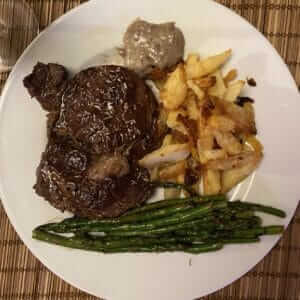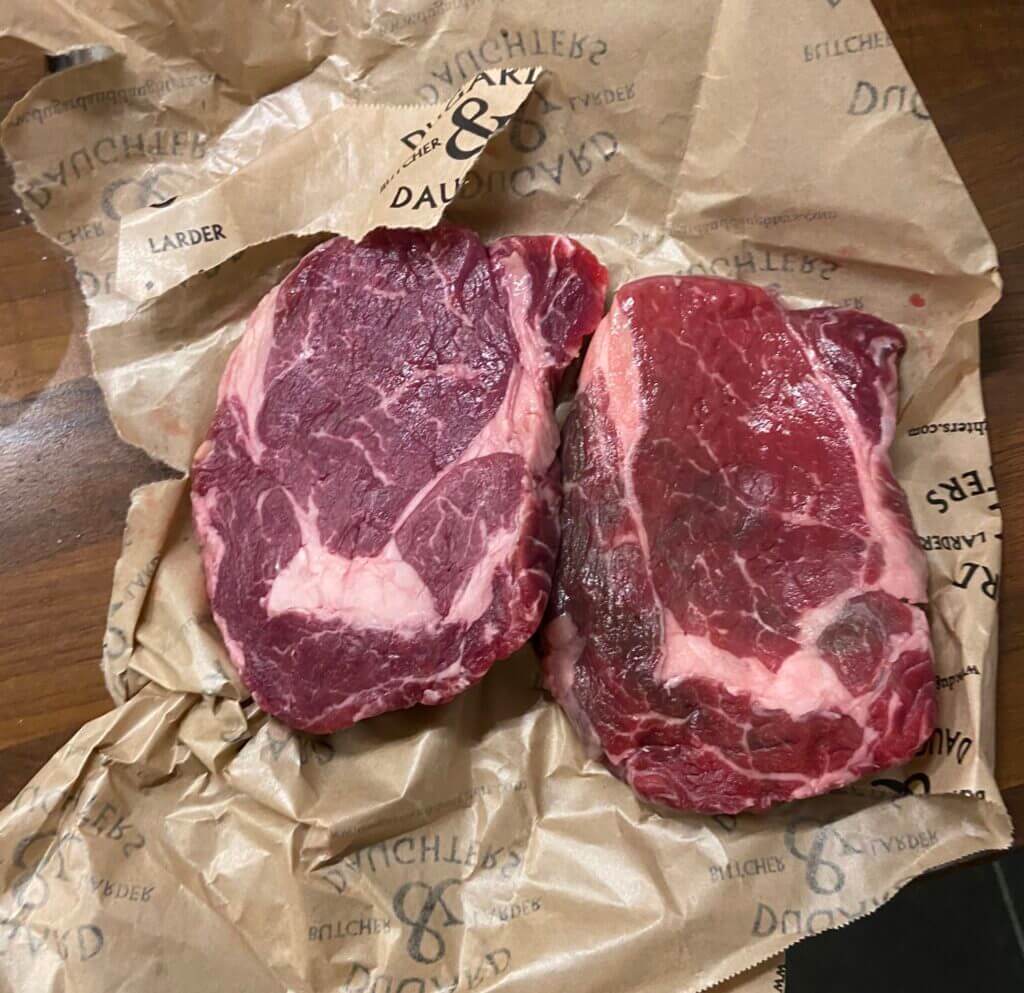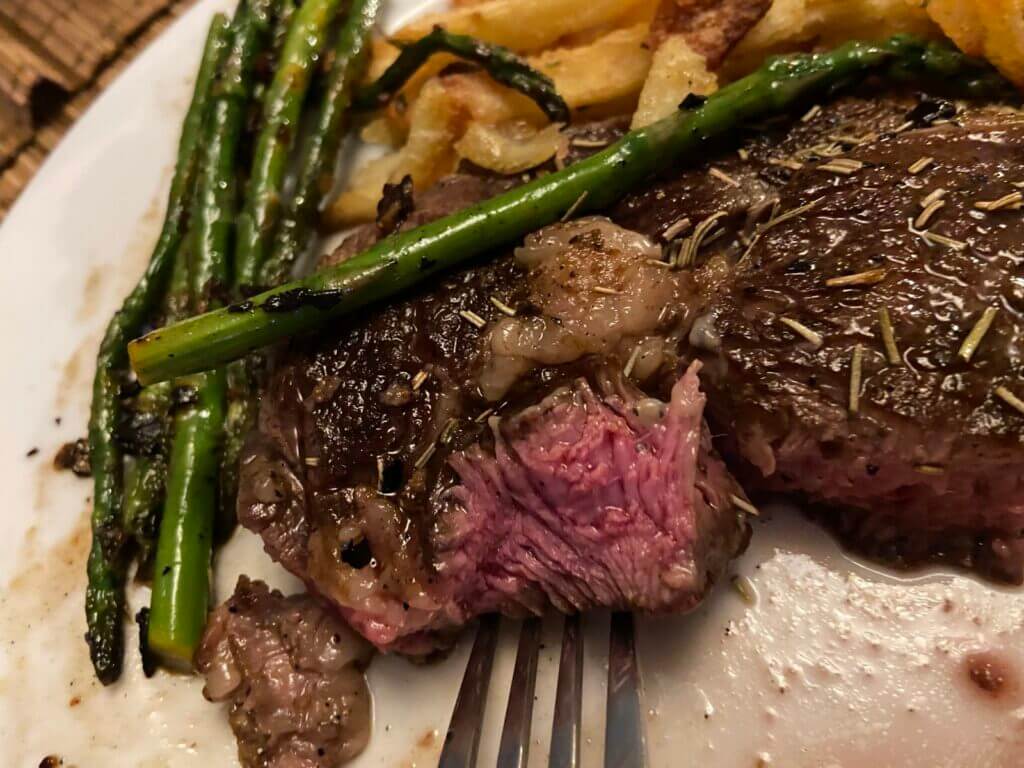Fancy Steakhouse Dinner, But On a Budget
Going to a steakhouse is fun. It’s also prohibitively expensive. And while it might be hard to recreate the ambience of the Hawksmoor or Peter Luger’s in your own house, cooking a steak like they do isn’t. Meaning you can have steakhouse calibre cooking at a fraction of the price in your own dining room. It’s also easy.
I’ve got lots of thoughts about steak dinners and how to prepare them at home, which I’ve included on the other side of the recipe. But the important things first:
This is a recipe for two, but it’s easy to scale it up to suit as many people as you need.
This is an indoors recipe. Grilling outside is fun, but most steakhouse steaks are cooked similar to the method here.
I prefer ribeyes, but filets or NY strips work as well. Porterhouse and T-bones less so (read the after dinner thoughts for more).
The recipe is concerned with cooking steak a certain style. I’ve paired it with roast potatoes and asparagus, but as the length of any steakhouse menu’s side dishes indicates, you’ve got options.

Steakhouse Dinner
Equipment
- Either a Grill Pan or Cast Iron Pan (ideally both)
- Small Sauce Pan
- A pot (to parboil the potatoes)
- Small whisk
- Baking Sheet + tin foil (or baking mat)
- Chef's Knife
- Metal Tongs
- Spoon or Spatula
- Pestle and Mortar (optional)
- Colander (optional)
- Mixing bowl (optional)
Ingredients
For the Steaks & Sides
- 2 steaks (Ribeyes, Filets, Strips) ~10oz each (300g), ideally 1.5in thick
- 125 g asparagus tips (A solid handful) If you get whole asparaguses cut them about halfway through so that you're left with the more tender half.
- 500 g medium potatoes (~1 lb) Cut how you want to – we did frittes/fries but cubes would work as well.
- 60 ml vegetable oil For potatoes
- 3 cloves garlic – minced For asparagus
- 2 tbsp olive oil For asparagus
- 1 lemon To be juiced and quartered – for asparagus
- 40 g butter For the steak – baste to taste (~20g per steak)
- 1 tbsp dried oregano For potatoes
- 2 sprigs rosemary For steaks
- Salt To taste
- Pepper To taste
For the Peppercorn Sauce
- 15 g butter (6oz)
- 15 g flour (6oz)
- 50 ml milk
- 7 g whole peppercorns (to be crushed) If you have a pestle and mortar, great. If not, just take your whole peppercorns and put them in a plastic bag and crush them with something heavy. Don't over-crush them, though, as they'll lose their flavour.
- 50 ml chicken stock About half a cube and a cup of water if you're in the UK
- 1 splash grape-derived alcohol (red wine, brandy, etc.) To taste, really
Instructions
Peppercorn Sauce
- Start with the peppercorn sauce, as it can hang out by itself once it's done. It also requires a lot of attention, so best to get it out of the way first. (See notes below) Crack the peppercorn in a mortar with a pestle if you have one. Don't pulverise it too much though, as the more it's crushed the less fragrant it will be. If you don't have a pestle and mortar, just put it in a plastic bag (or between some layers of saran wrap) and run a pan or a baking pin over it.
- Melt the 15g of butter in the saucepan on low heat. Wiggle your pan around to ensure even coating and zero risk of burning.
- Once the butter is melted, you'll begin to add the flour. Add it a teaspoon at a time and whisk it promptly and deftly. When the flour has clumped up with the butter, add another teaspoon. Repeat until you're out of flour. By the end, it should look kinda pasty, like clumps of cookie dough. Keep cooking it for a minute or two longer. This ensures that the flour-y taste is cooked out. Once you're done, congratulate yourself if this the first roux you made: this is the base for all the French sauces out there.
- Now's the time to add a splash of wine. Just a bit will do. Red wine will give your sauce a darker, purple colour. You can also try brandy or grappa. Stir it in quickly.
- Now add the milk. Pour just a bit in at a time, whisking as you did when you were adding the flour to the butter. The key here is to add just enough milk to the mixture that the paste dissolves into a thick liquid, but no more. The second it no longer has any clumps, add more milk. Repeat until you've used your milk up.
- Dump your peppercorns and chicken stock in. Stir frequently until you get the desired consistency. The longer you cook, the thicker it gets. 3-5 minutes usually does it for me. You can just leave it at room temperature after it's cooked. Warm it up right before serving by putting it over low heat for a couple of minutes.
The Roasted Potatoes
- Preheat oven to 220ºC fan (425ºF bake)
- Cut potatoes into you desired shape. Most recently, we cut them as fries/frittes, but cubed potatoes will work as well and can be cooked the same way.
- Fill your pot up with water and bring it to a boil. Add a healthy amount of salt at some point before it boils. Once it's boiling, dump the potatoes in. Cook for 7 mins.
- Take potatoes out. Drain into collander and move to a mixing bowl. Let them rest for 5 mins. Afterwards, drizzle 60ml of vegetable oil over the potatoes. Throw in a few pinches of salt (1-2 tsp). Give it a good shake to mix it up.
- Prepare your baking pan with its sheet or mat and scatter the potatoes over it. Put 'em in the oven. You'll want to cook them for 40-50 mins. But every 15-20 mins you should check on them and rotate the pan to ensure they're cooking evenly. The goal is to take them out right as you're putting the steaks on the grill pan. Cover with foil until prepared to serve them.
Asparagus
- After you put your potatoes in the oven, get a small tray or bowl and dump the asparagus tips in with the 2 tbsp of olive oil and 3 minced garlic cloves. Assuming you've quartered your lemon, squeeze half of it over the asparagus and put the two quarters in there with the asparagus. Give it a shake. Let it sit outside of fridge until ready to cook (35-40 mins)
- Timing when to cook the asparagus is important. Ideally, when you're basting your steaks with butter is about the time you should start cooking your asparagus. If you're using both a grill pan and a cast iron pan (as we do), when you move the steaks from the grill pan to the cast iron pan to baste them, add the asparagus to the grill pan, lowering the heat to med-high. Cook until tender, about 3-5 mins, shaking the pan frequently and frantically. Squeeze the other half of lemon over just before taking off. It should sizzle and kind of deglaze.
Steaks (see notes)
- Move steaks from out of fridge 20 mins before cooking them. Just before you're about to cook them (like literally right before), generously coat front, back, and all sides with salt and pepper. This is the only seasoning you really need (see 'After Dinner Chat' for more musings on this).
- Heat grill pan to high heat. Test heat by flicking water onto surface. If water immediately evaporates and gives off a loud sizzle, it's hot enough. Your heat should be as high as your pan allows (which for most grill pans is max heat; if only using cast iron, med-high will get the pan hot enough, but you'll need to give it more time to warm up).Separately, heat the cast iron pan to low heat. Add half of the butter you'll use to baste at this stage. The pan shouldn't get hot enough to burn the butter, but it should melt it so that it's fragrant.When grill pan is ready, add both steaks to the grill pan. Cook steak for 30 seconds on one side before flipping and cooking for another 30 seconds on the other. Afterwards, sear the sides of the steaks for a few seconds all around. Your steaks should at this point have a deep brown sear across their surface. This is called the Maillard Reaction and it's largely how steakhouses make their steaks taste so good. If your steak looks at all grey, your heat is not high enough.
- At the point where your steak is seared all the way around, for a 1.5in thick steak, another 45-60 seconds at high heat on both sides will yield a rare steak. Any longer than that and you start to enter the medium side of things. For rare/medium rare: cook in grill pan for no longer than 3 mins 30 secs total before moving to cast iron. I err on the side of caution and stick to under 3 mins total. For medium/medium well: no longer than 4 mins 15 seconds in grill pan.
- Basting in butter should take around 60 to 90 seconds max. Turn cast iron pan heat to medium when moving steaks over to baste. (This is where I'd add the asparagus to the grill pan, lowering the heat to med-high, cooking for a few mins until tender, shaking the pan frequently and spastically. Squeeze the other half of lemon over just before taking off.) When steaks are in the cast iron pan, add the remaining butter on top of steaks, and swirl the pan around constantly, using a spoon or basting brush to continuously move the butter cooking in the pan on top of the steak. You really don't want your butter to burn. Throw your rosemary sprigs onto the steaks if using. Once butter is melted, get the steaks away from the heat by putting them on the plate.
Plating
- I'd advise the table to be set and the red wine poured before you start trying to plate. Get the steaks on the plates, then add your potatoes, which will still be warm from sitting under the tin foil. The asparagus should be ready around this point. Make sure they are tender before taking them off the grill pan, but not before squeezing the remaining lemon over it. Give the peppercorn sauce a stir, as it will have congealed somewhat. Serve as desired (on top of the steak or on the side). Alternatively, you can bring the saucepan to the table and serve there. By the time everything is plated and you have sat down, the steak will have rested enough to cut into.
After Dinner Chat on Steaks
On the cut of beef and all things steak
I’m not a butcher, so it’s not like I know much about beef, but boneless ribeye is my favourite cut of steak to cook like this because it’s got the right balance of marble to meat. Marble is just fat, and beef fat is flavour, especially when it’s cooked right.
Another option for a steak dinner would be a New York strip, which is similarly marbled, though not as much as the ribeye and most of the fat is isolated to one side. 10-12 oz or 280-330g is usually enough for me.
You can also do a filet (aka filet mignon, tenderloin, or châteaubriand, depending on who you’re talking to), but I think they’re overrated and overpriced when cooked in the style of a steakhouse. While they’re tender, they’re actually not that flavorful (because there is no fat). You don’t necessarily need a pan sauce for a well-cooked ribeye, but you kinda do for a tenderloin (the exception being my grandfather’s Christmas tenderloin, but that’s cooked outdoors at temperatures so high I can’t convert them to Celsius and it’s a totally different kind of steak than what you get in most steakhouses).
Notice how I said your ribeye should be boneless. I used to think bone-in steaks were the best. For starters they look better, and when cooked right, they’re probably juicier. But if you want to achieve steakhouse quality in your kitchen, unless you’ve got a high-end broiler or some kind of sous-vide machine, cooking bone-in steak on a cast iron or grill pan will lead to an uneven sear because the meat will start to wither away from the bone once it hits the hight heat. Bone-in steaks like porterhouses or t-bones (or bone-in ribeyes) will do better on a high heat open flame (go to Florence, Italy and have their bistecca alla fiorentina to see what I mean).
What about your cheaper cuts of beef like sirloins, tri-tips, flank steaks, and hangar steaks? I love them, and they’re usually a better bang for your buck at the end of the day. They also deserve their own blog post because they lend themselves to a different kind of cooking style. But briefly, these are the steaks where you want to marinate them in something more than salt and pepper, as they tend to be leaner.
In Defence of Salt and Pepper as the Only Marinade You Need
Speaking of marinades, if you’re going to spend over £10 on a single cut of steak, you may as well enjoy their natural flavour. Salt and pepper accentuates the natural flavour without adding anything extra. On the other side of cooking, a bit of butter and a small bit of herb does the same thing. Fresh, high quality cuts of meat tend to be minimalist in their presentation for this reason (think of sushi).
Pan sauces are optional, but the good ones are those that blend in nicely with the meat’s natural flavour (peppercorn, obviously, but see also marrow sauces, or, to depart into a different cuisine, herb-heavy chimichurri sauces). Leave the A1 for poorer cuts of beef (something I remind my pops from time to time).
On Butchers and Picking your Steak
One of the cooler things about living in the UK is that there are loads more local butchers than what you tend to find in the USA. They’re also not as expensive as the ones in the USA, particularly if you shop at halal friendly butchers.
That said, when we go for ribeyes, we usually go to the more premium hipster butchers. The steaks pictured here are from a butcher in Herne Hill, and I think we paid £18 for two steaks, weighing a little over half a kilo. It’s not a cheap dinner by any means, but consider that the same cut costs three times the price at the Covent Garden Hawksmoor (plus another £15-20 for the sides each, bread, a cocktail each, three glasses of wine…)

As for questions about dry-ageing, how long you should dry-age your steak, I don’t really have a clue about that kind of stuff. The steaks cooked here were dry-aged for four weeks. I think a ten-week dry-aged ribeye would have cost us about £5 more for each steak. And I’m not convinced the premium is worth that much.
There are loads of documentaries and cookbooks out there about the minutia of beef and steak: what sort of feed is best for the cow, which breed is the best… And while I’m sure it makes a difference I only half-pay attention to that kind of stuff. What I do know is that locally sourced steak like from the Herne Hill butcher I mentioned tends to be a bit gamier and flavourful than your standard supermarket cut of ribeye. It’s a preference thing though, and I try not to be too much of a dick about it.
On High Heat/Quick Cooking
There are other ways to cook premium cuts of steaks like sous viding them or reverse searing, but I must confess I don’t know much about those techniques. But what I can say is they take longer and there are more moving parts, and you’ve got to factor in the energy expended versus reward. I’m not convinced they can make a substantial difference, but maybe I’m just lazy.
In defence of this method: I like it because I know that many of the world’s famous steak restaurants use very similar styles. It’s fast and easy, and as long as your timing and temp is right, it will come out tasting good.
Speaking of temperature, I’m usually a big fan of using an instant thermometer for checking doneness, but with this dish, I’ve found it’s best not to overthink it. You’re dealing with such high heat that things cook very quickly, and trying to time my readings to a thermometer has had me fuck up in the past. I will always prefer to have a very rare steak than a medium steak, which is why I’ve learned to pull it slightly earlier than my gut tells me too.

More on Steaks
The reason I use two pans is because I like the grill marks that a grill pan gives your steak at high heat. They also can get to higher heat more quickly than cast iron and I don’t feel as bad about running it as hot as I do our cast iron pan.
If you want to baste your steaks in butter, which is what steakhouses do, you can’t go adding butter to a grill pan set to max heat because it will instantly start to burn the butter. Burnt butter tastes like shit, and you’ll ruin your steaks if you do it.
Having a separate pan ensures that you keep the temperature low enough to not burn the butter. It also allows you to keep cooking your steak at a lower temperature after the bulk of the cooking has been done, cutting down slightly the time you’ll need to wait to cut into your steak after you’ve taken it off the heat.
Most people use one pan (typically cast iron), and either dramatically lower the heat before adding butter or taking it off the heat completely. I’m just cautious when it comes to cooking steaks that cost £10 each, and I know how mad I get when I overcook a steak, so I use two to better control the temperature.
On the Peppercorn Sauce
I try and make only enough for a single serving, but you could double it and refrigerate or freeze it for later.
Also, a steakhouse will use heavy cream instead of milk. I’ve not actually done it with heavy cream, but the ratio of cream to flour should remain the same.
Finally, the most important thing when making any kind of pan sauce like a peppercorn sauce is to constantly and continuously stir. When dealing with milk, flour, and butter, the mixture needs to congeal first (butter + flour) and then dissolve (+ milk) in the right way. I’ve found a constant stir, alternating clockwise and counter- will ensure you don’t burn it or otherwise fuck it up.
On Side Pairings
I like potatoes and asparagus because they’re easy to cook alongside the steaks, there are not loads of ingredients, and they’re cheap, yet it’s similar to what I would pair with my steak at a restaurant. The roast potatoes pretty much take care of themselves once they’re in the oven, and the asparagus are almost an afterthought as you’re dealing with finishing the steaks.
That said, I’ve done basically the same asparagus dish but with wilted spinach (like literally just sub out a bag of spinach instead of asparagus tips) and it works as well with the added benefit that it’s even faster.
There are more luxurious ways to do roast potatoes (cooked in goose fat, e.g.). I grew up with baked potatoes as the obvious complement to steak (topped at the table with sour cream and butter), but for whatever reason, I can never find the right kind of potato here in London.
Mash potatoes are another great option, but they take more energy and tend to come with a higher calorie load, especially if you want them to taste like they do at Peter Luger’s (for every kilo of potatoes, add 500g of butter the saying goes).
For veggie sides, creamed spinach always sounds good, but I can never justify it to myself. There’s also options for other roast veggies, like cauliflower and cheese or broccoli. Mac and cheese is a very American addition and which I remain unable to convince Valeria of trying.
If you were to do a dinner party (which we are in fact planning on doing), there would have to be a starter salad, either a Ceaser or wedge with bacon and blue cheese. Bread should be available of course. As will some seafood starter of some sort to really make it feel more like a night out (lobster tail, smoked salmon, crab if you can find it).
But note that the overarching theme of steak dinners is that they are fundamentally very simple, despite having an air of luxury and pretension (especially excepting for any seafood kickers).
